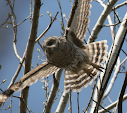
To be fair, I have no idea if the bird in the picture above is a Black Scoter. There is a fair chance that it is the right bird, but no matter how tight I zoomed in on the frame there was no detail after shooting at long distance and into the light.
More on this bird though, back at the end of November a birder spotted and identified the Black Scoter that was hanging about at Baseline. On a side note, Scoters, whether Black, Surf, or White-winged - are all pronounced 'skoh -ters' with a long "o". Having never really had much reason to study them closely I kind of dismissed them incorrectly as Scooters, and then after I noted the spelling, I had it in my head that they were Scotters, like the dogs I guess, but with feathers instead of fur.
So anyway this Black Scoter, a female or immature bird, has been hanging around at the most readily accessible large reservoir from my work, and I have missed it multiple times. Reduced daylight has kept me limited to quick scans at lunch on weekdays. I gave a quick look while scouting for the CBC, but missed it then. Often I was limited to scanning with bins or taking photos like the one above with my camera, (non-digiscoped) and zooming in to see if I could identify the bird.
For me, a new or life bird gets held to the highest standard for identification. Ideally it gets photographed and clear fieldmarks are visible, or other birders more familiar with the species are around to confirm the call.
In this case the bird was known to be around, but the large size of the water surface and limited times of day were keeping me from locating the bird, or seeing it with enough quality to distinguish it from the other species around.
This morning I took an earlier than normal lunch and set up the scope to scan for the bird. After a couple of misses I finally found it, and scrutinized it closely for markings. The bird showed a white cheek, and dark contrasting crown stripe. It had a darker body, which varied in the light as the bird turned from a dark brownish grey to almost black. At one point while in scope the bird rolled as it preened and showed that it clearly had a dark underside to go along with its one visible dark foot. At no time did I see an upward pointed tail that would have been likely for a Ruddy Duck, and it did not did not have an eye-line in the cheek, (female), or bluish tinge to the bill, (male). I was glad to have finally located this bird, and to have the ideal conditions to identify it, even if it remained out of range for photographing. I did try for a shot though - the effort; (above), was from after I drove to the north side of the lake and attempted a shot from closer range. The remaining ice kept the bird more directly south of me than I had hoped, creating a nice reflection shot - but a bit of a failure for a detailed bird image.
The Black Scoter was one of three species I had hoped to add to my list in the last month of this year. The others, a Black-legged Kittiwake that I missed once at Union Reservoir, and the still eluding me Rough-legged Hawk may have to wait until 2011. I am off to Minnesota in the morning, and will only be back with two days left in the year.
As they stand now:
2010 Count: 211
Lifetime: 252

Have a good and safe trip Dave!
ReplyDelete